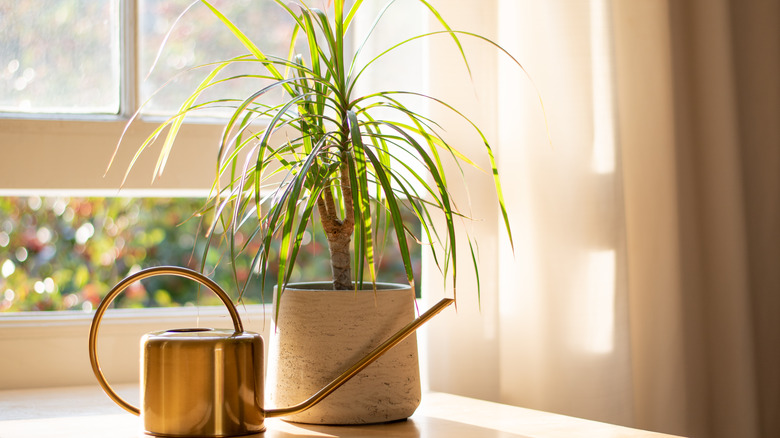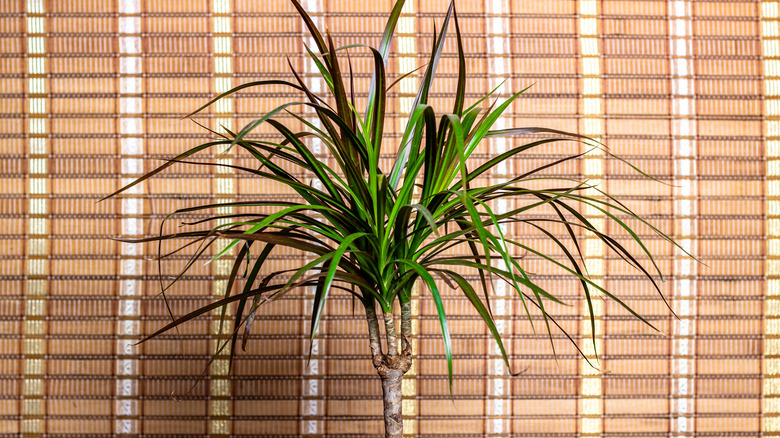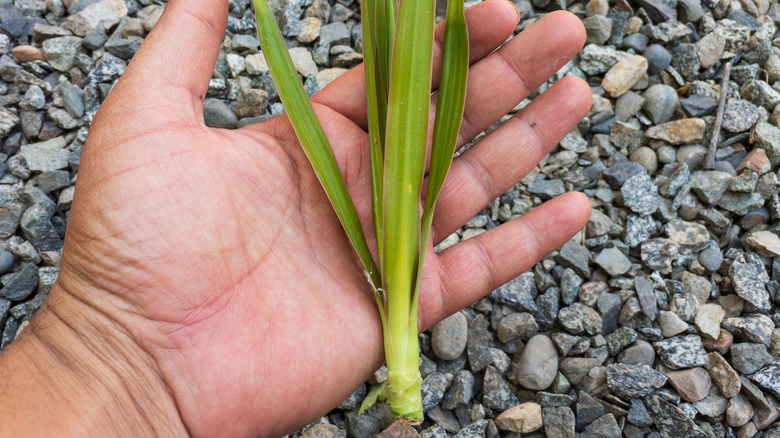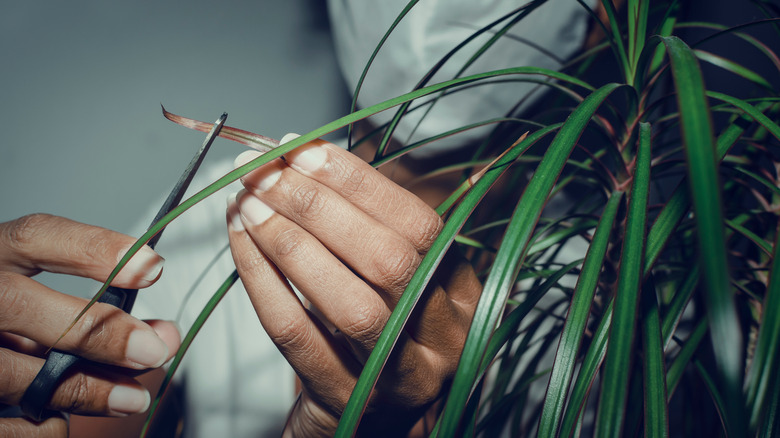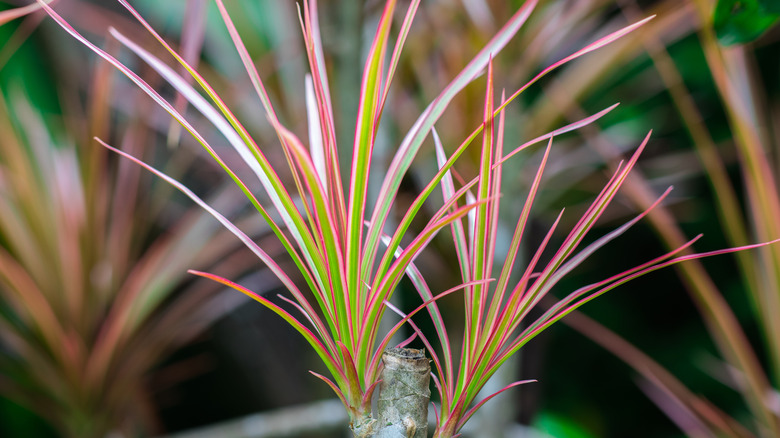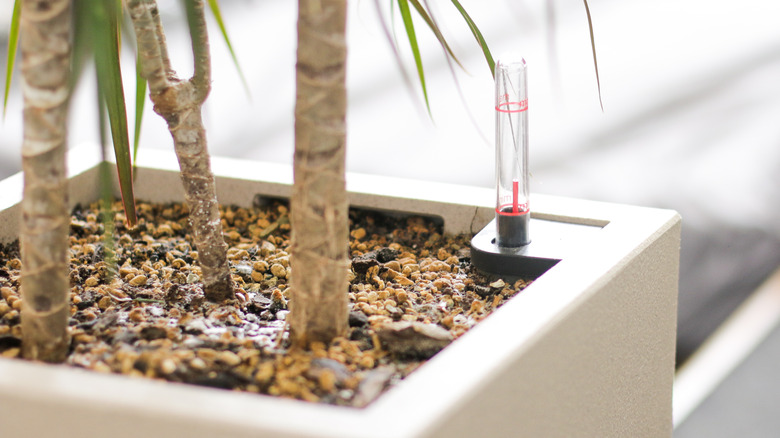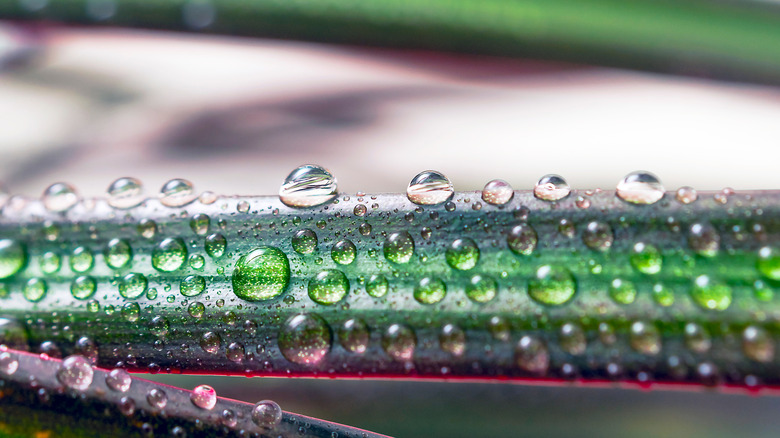Dracaena Marginata: Everything You Should Know Before Planting
The dracaena marginata, which is also referred to as the dragon tree, ranks high among houseplants that are easy to grow and care for, according to the Houseplant Resource Center. Also known as the Madagascar dragon tree, since Madagascar is its place of origin, the dracaena marginata sports long, slim leaves with pointed tips with a subtle hint of red around the outer edge of the leaf. The trunk is also slender, and in its native, tropical environment, the dragon tree's trunk can take on a straight or curvy formation.
As a houseplant, you won't have to be concerned about its height or formation if you trim it regularly. Aside from the pruning, dracaena marginata proves to be simple to grow and maintain due to its drought resistance and tolerance of various temperatures — though the plant thrives the most in warm climates.
Gardeners love to use dracaena marginata as an accent piece and as an ornamental plant in doorways. Aside from their attractive coloring that goes with just about any décor, the plant has some environmental perks as well. NASA chose it as part of a study on how houseplants help rid a room's atmosphere of harmful chemicals. As you can see, this plant would make a lovely and useful addition to any interior design.
How to use dracaena marginata in garden
If you live in an area that stays warm and humid all year round, like southern Florida or southern California, the dracaena marginata adds a special aesthetic to your outdoor garden or patio. You can surround it with smaller shrubs and colorful flowers for contrast or have a designated spot of its own surrounded by rocks of various hues or sand. Also, the dragon tree can be planted in decorative pots to strategically place in the corners of your patio where they're not exposed to excessive sunlight.
Regardless of where you place them, you'll need to remember that they don't fare well in cooler temperatures below 65 degrees, as noted in Nature and Garden. So during the winter, the dracaena marginata needs to be brought inside the house.
Thus for the most part, the dracaena marginata makes a better indoor houseplant. As a decorative accessory to your hallway or entryway, this plant adds texture and color to the overall scheme. It's also a popular corner piece for living rooms and other sitting areas. If you keep it well pruned, then it looks great on a coffee or end table. If you decide to let it grow a bit taller, then a large pot that sits on the floor or in a stand spruces up the space.
How to grow dracaena marginata
Of the many houseplants to choose from, dracaena marginata proves to be one of the easiest to grow. Your best bet is to start from a cutting or a young sapling purchased from a nursery. Once you've adopted your dracaena marginata, you'll need a pot with drainage holes and potting soil that allows for adequate drainage, per Nature and Garden. Peat moss or a small amount of compost would give the plant an extra boost, but that's optional.
Initially, gently loosen the soil around your plant's roots and hold it in the center of your chosen pot while gradually adding enough soil to support the stem. Also, if you want to make sure that water doesn't get trapped at the bottom, add a layer of tiny pebbles. Once you've planted your dragon tree, you can then water it, making sure not to overdo it. The plant thrives in humidity but not in a small flood.
When the time comes to propagate (in which spring is the season), you'll cut at least 8 inches off the stem and place it in a clear container of water. If you fill the container a little less than halfway, that will provide sufficient hydration. In about two weeks, you'll see the roots appear at the bottom. When the roots get longer, and you see leaf buds appearing at the top and side of the stem, your dracaena marginata is ready to be planted in a pot of moist soil.
How to care for dracaena marginata
Once you have your dracaena marginata well established, you'll need to water it on a regular basis, but be careful not to water too much or too often. In fact, if you went almost an entire week before remembering to water your plant, it would be fine since this type tolerates dry spells. However, you shouldn't go too long without watering as long as it's able to drain completely without sitting in water. The best way to gauge this is to check the soil from the surface to about halfway down to see if this part has dried completely. Also, you might consider using bottled water or soft water since the plant doesn't do well when it absorbs fluoride or minerals from tap water, as recommended by The Spruce.
In addition to drainage, you'll need to be mindful of the dragon tree's exposure to light. The dracaena marginata grows well with partial sunlight since its leaves are sensitive to bright rays and extreme heat, so you might consider spritzing your plant with water if your home doesn't have much moisture in the air. As far as fertilizer goes, you won't have to fertilize your plant often because of its slow growth. However, you can apply a liquid fertilizer to the damp soil just once a year at any time except for winter.
Varieties of dracaena marginata
The dracaena marginata, as mentioned, originally comes from Madagascar. Plus, you can find other varieties in tropical areas in southern Asia and northern Australia as well as other parts of Africa. According to the Houseplant Resource Center, the dracaena has 120 varieties, many of which can grow as tall as 20 feet in the wild. As a houseplant, you can expect your dragon tree to grow up 6 feet depending on how often you trim it.
You can find beautiful varieties of dracaena marginata at many nurseries (as mentioned in Nature and Garden) which include:
-
Dracaena marginata "tricolor" — While the tricolor bears the signature green and red bands, the bright, golden stripe in the middle draws more attention.
-
Dracaena marginata "magenta" — The magenta definitely stands out as much as its namesake with its deep reddish, purplish foliage and shorter stem.
-
Dracaena marginata "colorama" — Probably the brightest out of the dracaena family, the colorama takes on a pinkish tinge on one side of the leaf, while the green is located on the underside.
-
Dracaena marginata "tarzan" — The tarzan possesses a higher price tag than the other dragon tree varieties, but its other differences include a wider stem and leaves that grow in a spherical formation.
-
Dracaena marginata "bicolor" — This variety bears the two most common traits of the dragon tree which are the green leaves that are slightly lighter than the original and surrounded by a strip of scarlet.
Is dracaena marginata toxic?
The dracaena marginata has never been fit for human consumption even if it doesn't warrant a visit to the emergency room. However, you need to keep it away from your pets due to its toxicity. According to Gardening Know How, you should to prevent your dog or cat from eating the leaves. They contain a substance called saponin that's quite hazardous for animals. In fact, if you think your pet might fall into the temptation of chewing on the leaves, then place the plant on a higher spot out of their reach or in a room that can be closed off to where your pet can't enter.
If you suspect your pet has eaten a leaf from the dracaena marginata, then you should contact your vet immediately to avoid dehydration. Some symptoms to watch for in both dogs and cats are nausea and vomiting, diarrhea, and fatigue as well as watering or foaming at the mouth.
How to repot dracaena marginata
Repotting a dracaena marginata might be the only challenging aspect of plant care because of its size. Fortunately, with its slow growth, you don't have to repot very often. The first step, according to SF Gate, to this process is to have your new (and larger) pot prepared with moist soil with a hole dug out in the middle to make way for the tree. Next, you'll gently pull the tree out by the base of its stem. You'll probably need to overturn the pot and tap the sides to loosen the soil. Once you have the tree removed, you'll need to loosen the roots just a bit.
Then, position the dracaena marginata in the middle of the hole and cover it with the soil surrounding it. You might need to add more soil to provide firmer support of the stem. Finally, you'll water the plant and spray it with bottled water while allowing for proper drainage.
How to prevent leaf discoloration
While the dracaena marginata doesn't require a strict regimen of care, you need to be aware of some signs of ill plant health that manifest as discolored leaves. For instance, according to Nature and Garden, the leaves turn yellow when you water too much and too often. Another sign of overwatering are limp, brown leaves. Likewise, if the leaves take on a brown hue specifically on the ends, then you'll need to switch from tap water, which might contain too high of a volume of fluoride and sodium, to bottled water. Finally, if the leaves of your dragon tree seem a bit "stunted" and very light in color, you'll need to expose your plant to more natural light while taking care to avoid direct sunlight that can dry up the leaves.
So if this is your first plant life adventure, the dracaena marginata offers an easy-to-maintain and easy-to-plant option. It looks beautiful as a decorative accessory in any room of your home, especially since you can keep it pruned to any size you like. Plus, when propagating, you'll be able to come up with additional plants for other spaces in your home or office — or you can gift them to friends and family.
